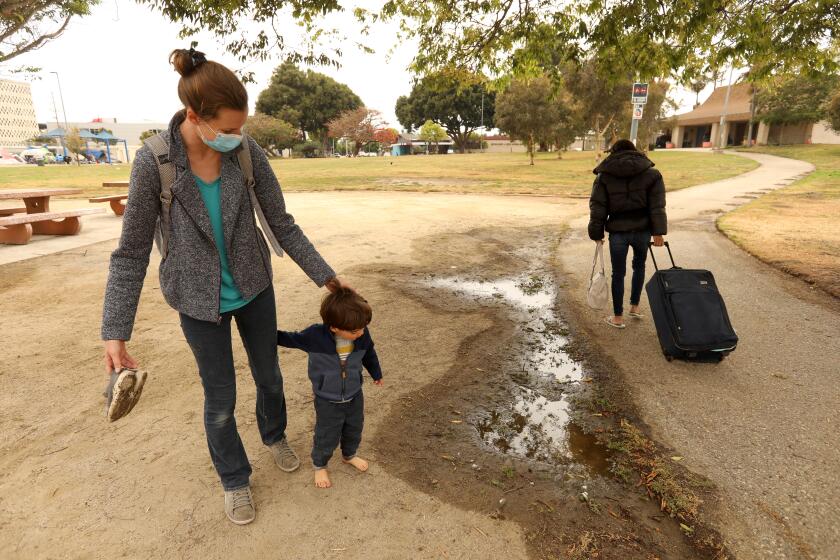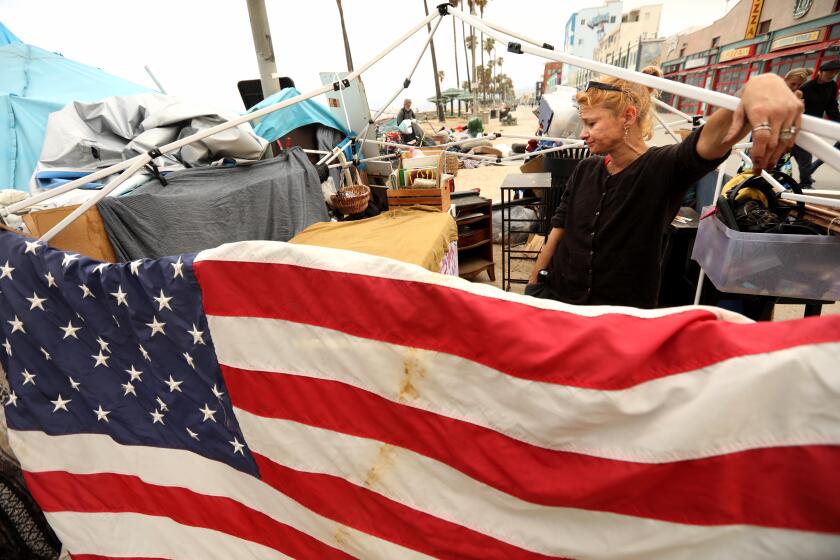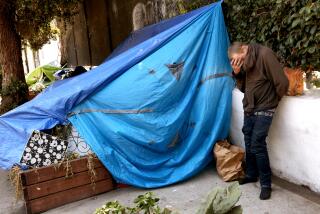Q&A: How Councilman Mike Bonin plans to fix Venice’s homelessness crisis
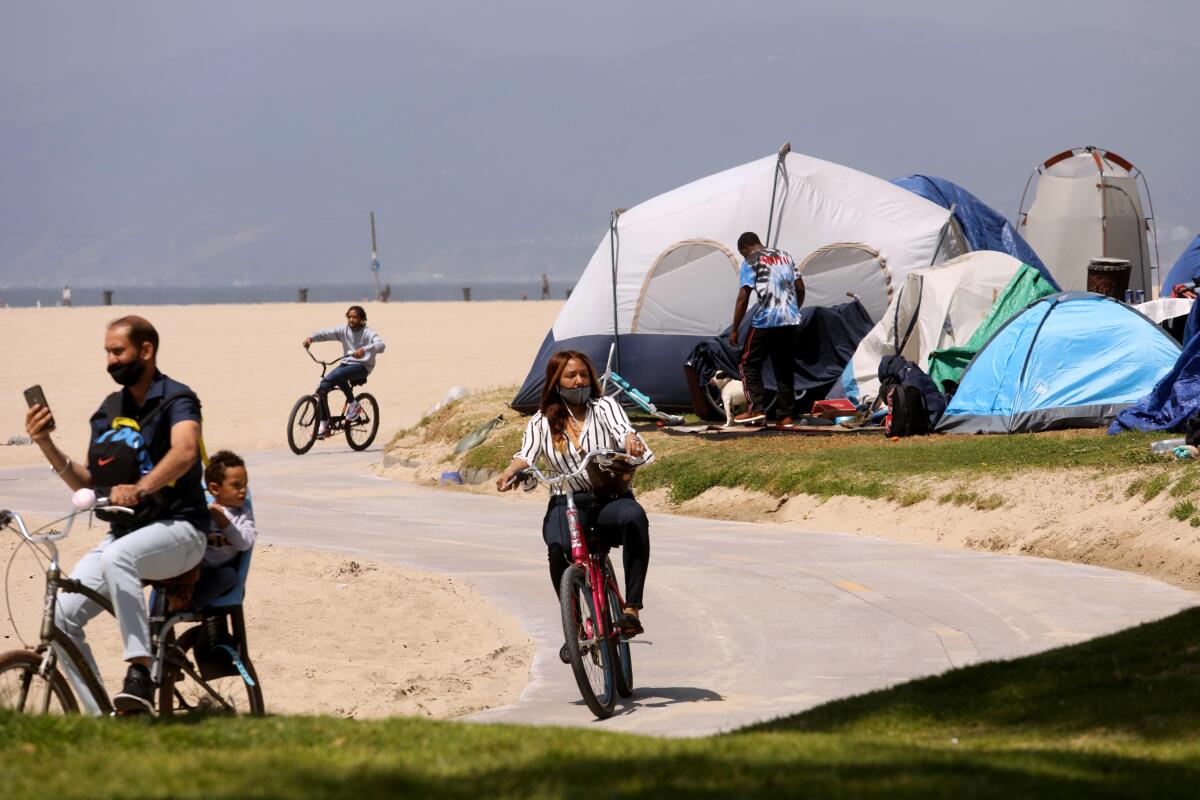
After spending weeks reporting on the homelessness crisis in Venice, Times reporters Benjamin Oreskes and Doug Smith sat down with Councilman Mike Bonin, who has represented the area since 2013. In a nearly two-hour interview, he weighed in on how the fights over homelessness have consumed the neighborhood and laid out his vision of how a humane clearing of tents that run along the boardwalk could occur.
This interview has been edited for length and clarity.
LAT: We’ve been talking to people you know over the past two or three weeks and we’ve been hearing a sense of anticipation that something’s coming. Are you planning something like the cleanup at Echo Park Lake?
Mike Bonin: It’s not going to be: Here’s the day, with bells and whistles and pressing buttons. I don’t want to do it this way. But I guess to a certain extent, it’s inevitable to do the contrast with Echo Park Lake, because that’s sort of become part of the frame of this.
So let’s start with the ways in which Venice Beach is different than Echo Park Lake. So even if I were predisposed to do this Echo Park Lake-style, it’s really hard to do it in Venice Beach for a couple different reasons that are purely logistical. It’s freaking huge. I think it would be logistically impossible to close off the entire thing as was done for a couple months at Echo Park.
I base that on two real-life experiences.
It was bad before. It’s unacceptable and intolerable now.
— City Councilman Mike Bonin
One is 21 to 22 years ago, we spent $15 million renovating the boardwalk. Even then, they closed off portions of it, but you could still do the boardwalk. It’s not just a park. It’s a park, it’s a beach, it’s a residential area, a shopping district, so you don’t have the same ability to just close it off.
Another example is at the beginning of the pandemic, when the city said the beach is closed, even with cops, the beach wasn’t closed, I mean, you would need more officers than they used at Echo Park Lake in order to physically close off Venice Beach.
I think you have to think of it differently, but you also can’t let the current situation continue where the whole thing is just an encampment.
LAT: Then what will it be?
MB: What we’re doing is we’re tying to do a more gradual, although increasing, approach. The first place we started was the handball courts. It was relatively small, it was 20 people or so, maybe a little bit larger, and that was because that was the first place Rec and Parks [Recreation and Parks Department] was going to open up.
What made it easier for us is that [the L.A. County Department of Public Health] that week eased up on the population restrictions for bridge housing, so we had more beds available right away. That made it possible to do the handball courts, and that went relatively well. Most people accepted a placement. I think a couple didn’t, but most did, after a lot of outreach.
L.A.’s search for new solutions to a growing homelessness crisis is running up against residents’ love of their beaches and park spaces.
So then the next thing is [opening] the skate park and the volleyball courts. So that happened two weeks ago. So we’re going to continue doing some of those areas. The next area that’s likely to come is going to be sort of the grassy area.
Starting this week [June 6], Monday through Wednesday, they’re doing outreach. This isn’t even starting something. This is sort of a warm up.
So once all the resources are fully lined up, then they will start offering housing to people, and anyone from that area says that they’re into it, that they want it, then if the number of available beds matches it, they’ll go right in.
As people are not immediately saying yes, they will do sort of zones, I believe, starting at the north and going down. They’ll focus really intently for a couple of weeks on an area and try to get people there housed and then they will do the second and the third and the fourth.
We will have the Ramada Inn [run by Project Homekey, which converts hotels into housing]. We will have some more bridge housing slots [at a local shelter]. We have a small amount of shared housing that I’m at work now in advance that hopefully opens up some bridge housing slots, and then people move into them. I have before the budget committee later this month a request that I’ve asked for before, but I think I’ll get it this time for a million dollars for shared housing in Venice. I think it would be like 63 beds right away they could provide.
As part of the budget request, I think was a $3 million or $5 million ask just for homelessness in Venice.
We’re not quite as big as skid row, but this has got to be the city’s second-biggest focus, because it’s one of the largest [encampments] and it’s also very densely populated.
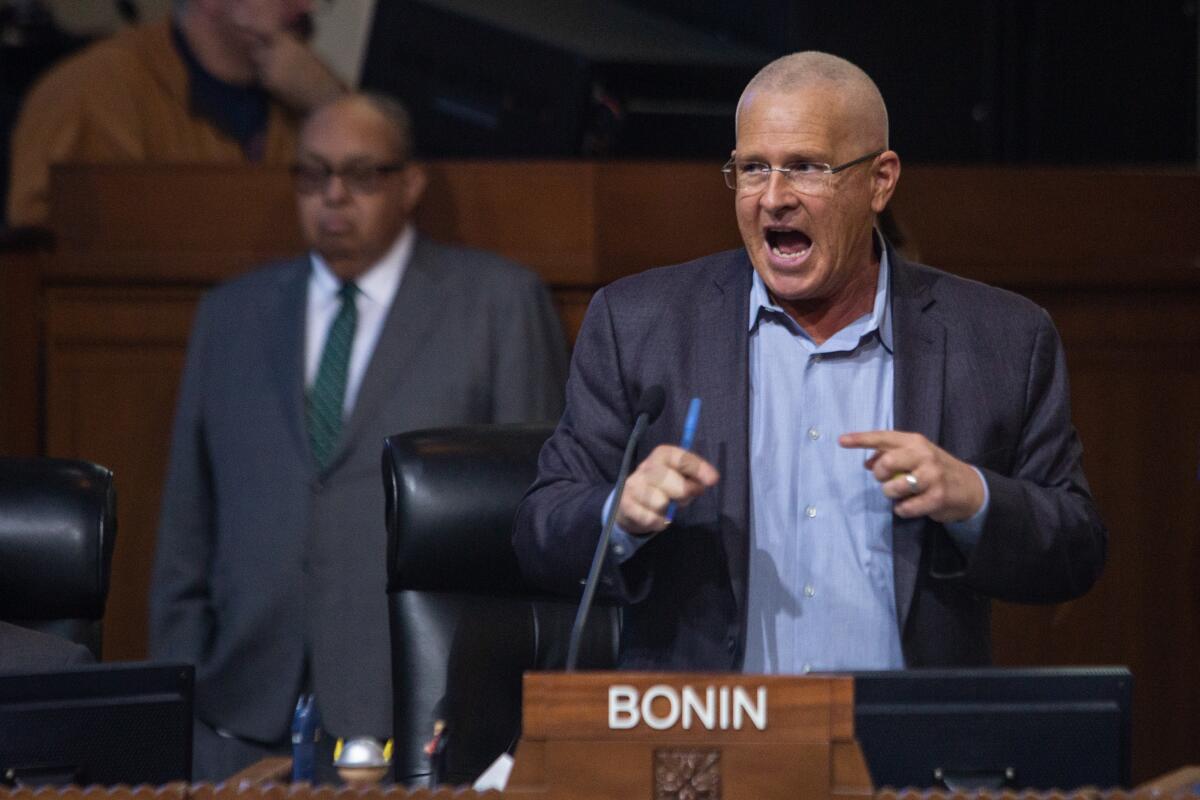
LAT: You have constituents who blame you for conditions on the boardwalk and don’t trust you to do anything about them. Does it make it hard to give this pitch to them?
MB: It was bad before. It’s unacceptable and intolerable now. We can talk about why I don’t say that kind of stuff more than I do. But it’s unacceptable and it’s intolerable. And it’s got to change.
With the beds opening, [A Bridge Home, Mayor Eric Garcetti’s signature transitional housing program] and Ramada will be able to show some additional early evidence of this working. So I think that there will be some signs of momentum. It certainly is never going to win some folks over.
Homelessness on the boardwalk, homelessness in Venice, to a certain extent, homelessness in other parts of my district, and I think in other parts of the city, just exploded during the pandemic. I don’t think there’s any denying that.
A plan for how to solve Venice’s homeless crisis has emerged from behind-the-scenes talks among a coalition of Venice activists, city officials and deputies of the area’s city councilman.
I think also things look like they’ve increased even more than they have, because of the way we changed our management of encampments. And so things look different.
Before it was a park that had some encampments in it. Now it has become an area that has become one of the largest campgrounds around and it was, I think, a confluence of factors.
More people became homeless in L.A. during the pandemic. Enforcement changed dramatically. Services changed dramatically.
There’s no perfect good, and there’s no absolute bad, there’s just, you know, a lot of complex choices.
LAT: The lack of a date for when no camping will be enforced on the boardwalks makes it hard for some of the constituents to back what you’re doing.
MB: I’m not going to give one until all the resources are in place and I can be confident about it. The one thing that would be worse than the current situation would be for me to pick an arbitrary date and then not deliver on it or to pick an arbitrary date and then move enforcement in without having the resources to provide the alternatives.
I get why people are angry, and I get why people are frustrated. The only thing that I can do about that at this point is to deliver.
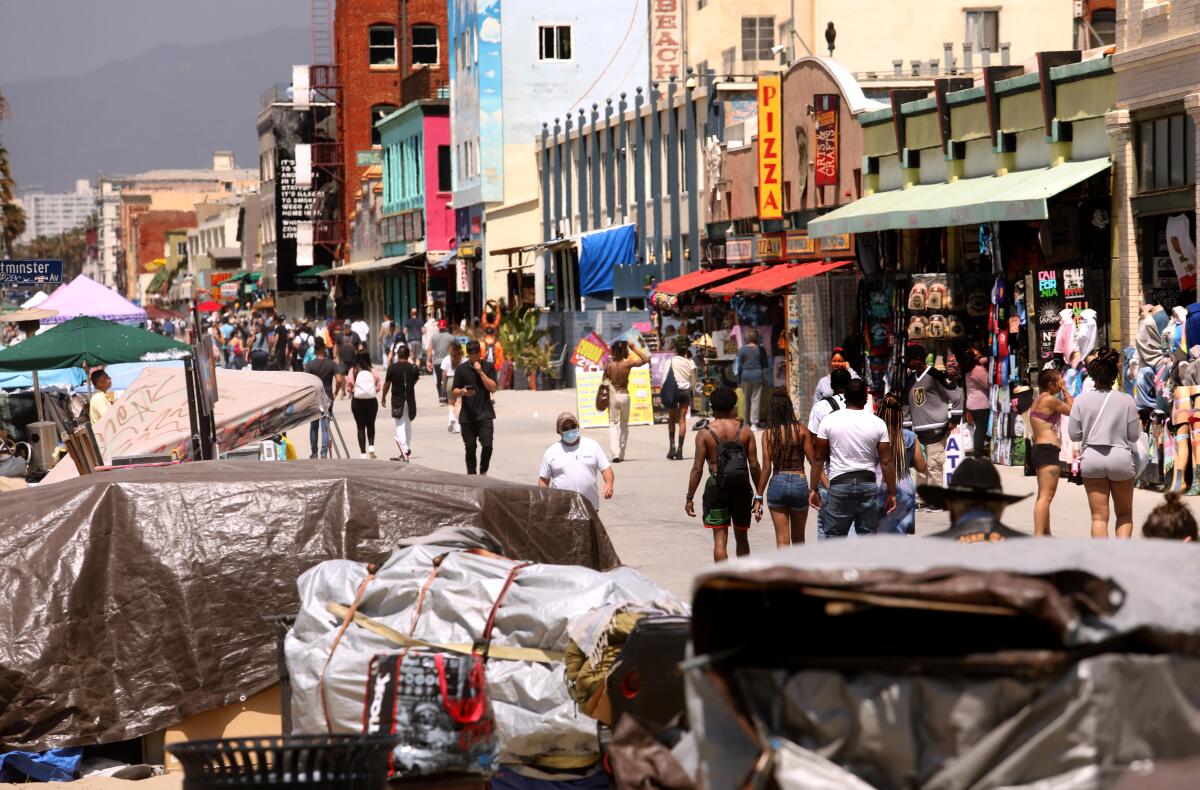
LAT: If you move the ones who accept a placement and then you deal in sections with the ones whose remain, how do you keep that section from reverting?
MB: I mean, that’s what they’ve done with the handball courts. Because you asked about fencing, I don’t know if there will be fencing on the berms or not. If they need fencing up for a period of time to reseed the grass or something, then OK. If it’s just a pretext, then I’m not wild about that idea at all. So I don’t know exactly what’s going to happen.
I’m not going to sugarcoat it. This is going to be hard. This is gonna be challenging, And there are going to be questions and circumstances that we’re going to be struggling with as we go through it. It’s just going to be different than anywhere else, because of the nature of it. There are challenges that I’m concerned about, too, and I’ll be honest about what they are.
One is, there are a lot of people who will accept [housing]. There are a lot of people who will initially say, “No,” and then will accept. There’s a lot of folks who will say, you know, “Screw it, I’m going somewhere far away,” and then there are some folks who will say, “I’m fine, I’m moving a block inland.” Then you’re even closer to somebody’s home. Some in [the Los Angeles Police Department] have voiced a concern about that.
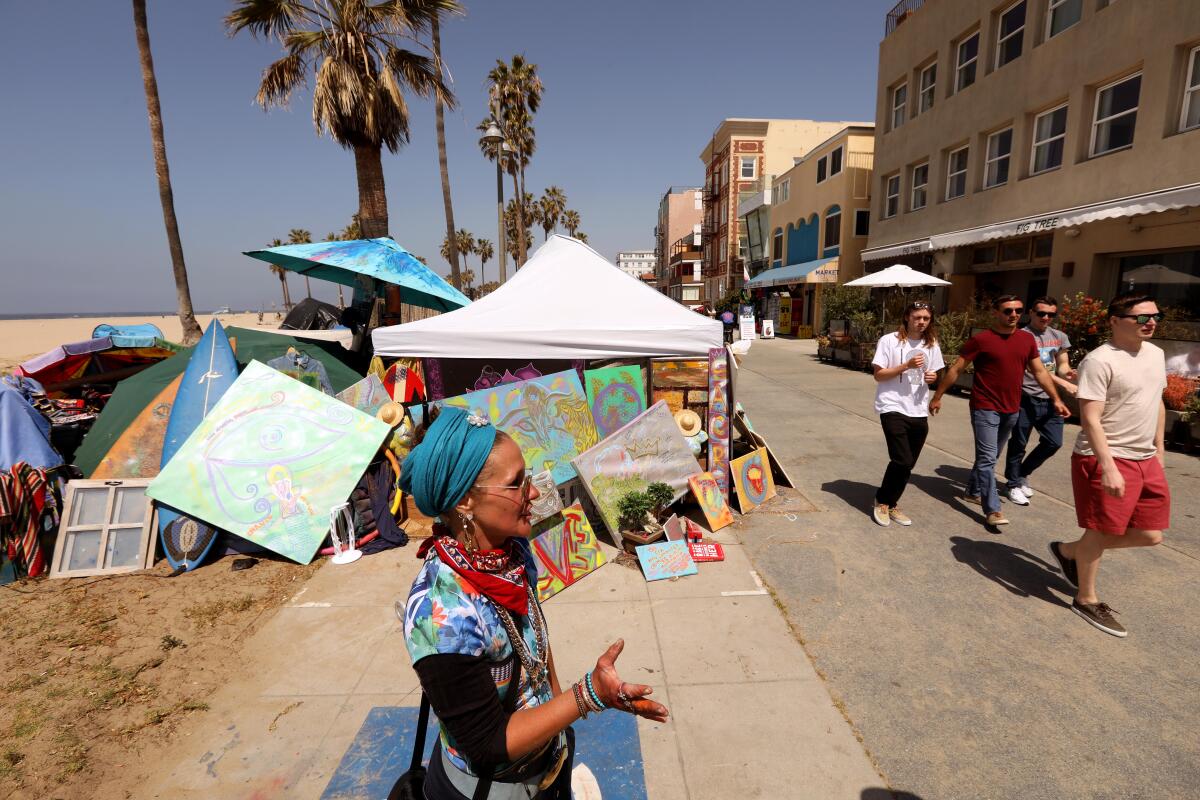
LAT: There have been these upswings in anger or frustration about the state of things in Venice. Does this one feel different?
MB: Let me first say that, I think that the population of people who are unhoused and the population of people who are housed in Venice have changed. There’s a lot of people who are new in Venice. They certainly weren’t around for the gang violence in ‘90s, or the previous time, and ’87 when there was a big population on the beach. So their perspective is, “This is where I live, and this is how I think it should be.” I think that’s perfectly valid, and that’s a very large, large segment.
The homeless population has also changed. I think that there’s definitely more addiction. I think St. Joe’s [St. Joseph Center] would tell you that there certainly are issues with mental illness. Those are all real. That raises tension understandably. I don’t think that that changes how you should evaluate what the appropriate responses are.
You need to treat criminal activity as criminal activity. And the person’s housing status isn’t relevant to the crime. If you commit an assault, you should be charged, and you should be prosecuted and you should be convicted.
I get worried when we attach it to someone’s housing status. I have also consistently said that we need housing with services. What we’ve come up against now is a public conversation that homelessness is a mental health and addiction issue and not a housing issue.
I don’t get how we got to a place where that’s an either or. It’s got to be all.
LAT: For many people though, they want the crime in front of their door solved.
MB: In the last budget, [we] got more resources for LAPD in Venice. The overtime increased. There’s a dedicated unit for near the ABH [A Bridge Home] again. Over the past year, the deputy chief has assigned an additional car at night for Venice Beach. Arrests for both felonies and misdemeanors are up significantly. I mean, that’s what you do to deal with the crime problem. You do stuff to try to prevent it.
More to Read
Sign up for Essential California
The most important California stories and recommendations in your inbox every morning.
You may occasionally receive promotional content from the Los Angeles Times.
